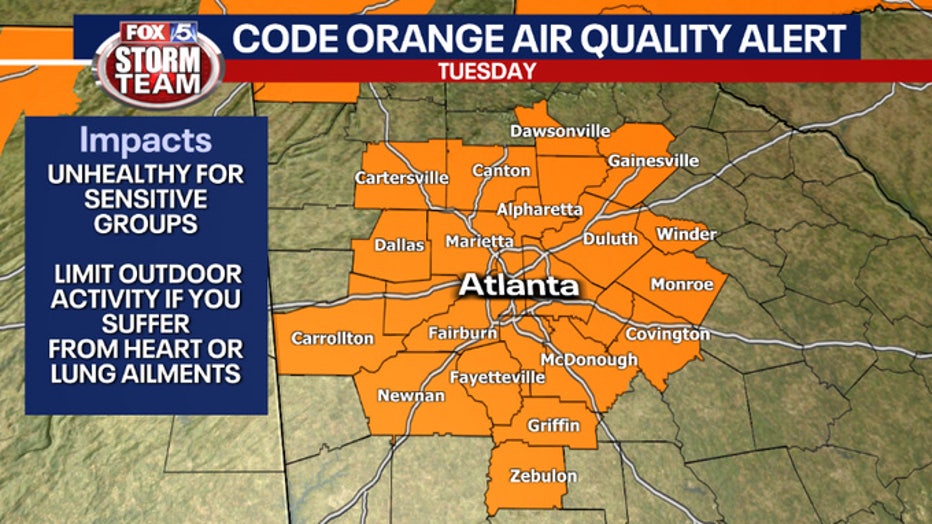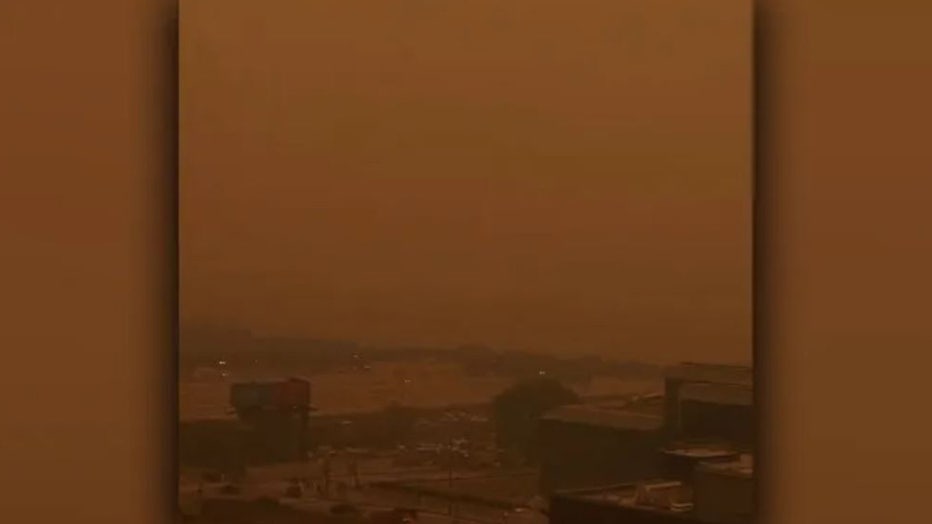Atlanta air quality: When will things return to normal?
Atlanta Track Club takes air quality in stride
While experts are telling many people to stay indoors during the deteriorating air quality we're experiencing across metro Atlanta, some people are taking in stride. Like the Atlanta Track Club. The group of runners are still getting their steps in despite the health concerns, and they shared their rationale with FOX 5.
ATLANTA - A Code Orange Alert was issued Tuesday for parts of Georgia, but what does that really mean? People flocked to social media and their choice search engines to learn more about the different colored codes and how the air quality in Atlanta would affect us. Here's a cohesive breakdown:
What is the U.S. Air Quality Index (AQI)?
What's the U.S. Air Quality Index, and why do we keep talking about it on the news? The AQI is what we use in the United States to report on air quality. Air quality refers to how clean the air we're breathing in is. Depending on where the quality ranks on the index on any given day, you may need to take special precautions to protect yourself.
The Index runs on a scale from 0 to 500. Zero indicates clean air with little to no risks related to pollution. Anything over 300 is absolutely hazardous.
CANADIAN WILDFIRES PROMPT AIR QUALITY ALERT IN ATLANTA

What do the colors on the U.S. Air Quality Index mean?
The U.S. Air Quality Index is broken up into six different colors, or levels: Green, Yellow, Orange, Red, Purple and Maroon.
Each color not only tells us where the air quality numerically lands on that scale from 0 to 500, but it also explains what portion of the population can expect to be affected negatively.
First, we have Green. A Code Green is considered "good" and is valued at anywhere from 0 to 50. When we're in the "green," pollution poses little to no risk to the population.
Next, is Yellow. A Code Yellow calls for a "moderate" level of concern, and is valued anywhere between 51 and 100. At this level, the air quality is considered acceptable, but there may be risks for some people, specifically those who have "unusual" sensitivities to air pollution.
Then, we have Orange. Orange means the air is considered "unhealthy for sensitive groups." It's valued anywhere from 101 to 150. During a Code Orange, the public may not be affected by the amount of pollution, but members of sensitive groups may experience issues with their health.
Smoke, haze bring poor air quality to Georgia
A yellow haze has taken over metro Atlanta once again as smoke from the Canadian wildfires makes its way south. FOX 5 sat with an expert to learn about the ways the current air quality can be bad for your health.
Then comes Red. A Code Red is considered "unhealthy" for the public. It's valued at 151 to 200 on the Index. More people may start to experience health concerns, while members of sensitive groups may experience more serious issues.
There's also Purple. Code Purple is "very unhealthy," at 201 to 300 on the Index. Everyone is at an increased risk of facing health concerns at this level.
The last category is Maroon. At this point, the air quality is considered "hazardous," at 301 and higher. A Code Maroon is an emergency for everyone.
Atlanta Air Quality, Tuesday forecast
Georgia was issued a Code Orange Alert Tuesday as the air quality diminished due to lingering smoke from the Canadian wildfires. Here's a look at how that will affect your FOX 5 Storm Team forecast.
Who is at risk when the air quality is bad?
Some people make the mistake of thinking only those with pre-existing health conditions like asthma or heart disease are at risk when the air quality drops. Everyone at some point can be considered part of a "vulnerable" group. For example:
- Children and teenagers
- Older adults
- People who live near major highways or factories
- People who work near major highways or factories
- People who work outdoors
- People who exercise outdoors
How does the air quality get so bad?
A number of things can affect our air quality. For example, Georgia is currently experiencing the aftermath, or spillover, of the Canadian Wildfires that have been burning for months. That smoke has been traveling and making its way further down south. While we're currently seeing smog across metro Atlanta, places like New York City saw hazy, orange skies in early June.

Scenes across New York City are seen on June 7, 2023, amid hazy conditions due to smoke from the Canadian wildfires. People in the city other areas are expected to have another day of bad air Thursday due to smoke from the Canadian wildfires. Air qua (Ezio Cairoli / FOX Weather)
We may also see changes in quality as a result of exhaust from our vehicles, dust on the road, increased or decreased pollen counts, gas-fueled yard equipment, and even chemicals you use around the house.
Ozone, a colorless gas that forms in sunlight, also plays a role. You've heard of the ozone layer in the sky, but it can also reach ground level.
"Ground-level ozone forms when two types of pollutants, volatile organic compounds and nitrogen oxides, react in sunlight. These pollutants come from sources such as vehicles, industries, power plants, and products such as solvents and paints," according to the United States Environmental Protection Agency (EPA).
How can I be safe when the air quality is unhealthy?
How to stay healthy under Air Quality Alerts
Smoke from the Canadian wildfires continue to cause bad air troubles across the country, and it's important that you don't risk your health when you can avoid it. Emory's Dr. Neil Winawer sits down with Kaitlyn Pratt to share some ways you can keep yourself safe and healthy when the air outside isn't.
Emory University's Dr. Neil Winawer sat down with Kaitlyn Pratt to discuss a few great ways to protect yourself from outside conditions:
- Opt in for an N95 mask
- Don't sleep with your pet
- Invest in an HVAC/Air Purifier system
- Use an inhaler before you go out
The American Lung Association provided the following additional tips:
- Avoid exercising outdoors and in high-traffic areas
- Limit the amount of electricity you're using at home
- Carpool
- Do not burn wood or trash
- Do not smoke indoors
The EPA weighed in as well:
- Get your activities out of the way earlier in the day
- Don't let your engine idle
- When putting gas in your car, stop when the pump stops to avoid spilling fuel
How long will this air quality last?
Experts say we won't see immediate relief from the smoke crossing the Canadian-U.S. border. Large fires in Alberta, British Columbia and Saskatchewan are likely to keep churning out smoke throughout the summer and possibly into early fall, according to Montana Department of Environmental Quality meteorologist Aaron Ofseyer.
"The worst is over with this round," Ofseyer said. "Unfortunately there’s still a ton of wildfire smoke north of the border. Anytime we get a North wind, we’re going to be dealing with Canadian wildfire smoke."
The FOX 5 Storm Team will keep you updated as it pertains to our area. Keep up with the latest by downloading the FREE FOX 5 Storm Team app and following @FOX5StormTeam on Twitter.

